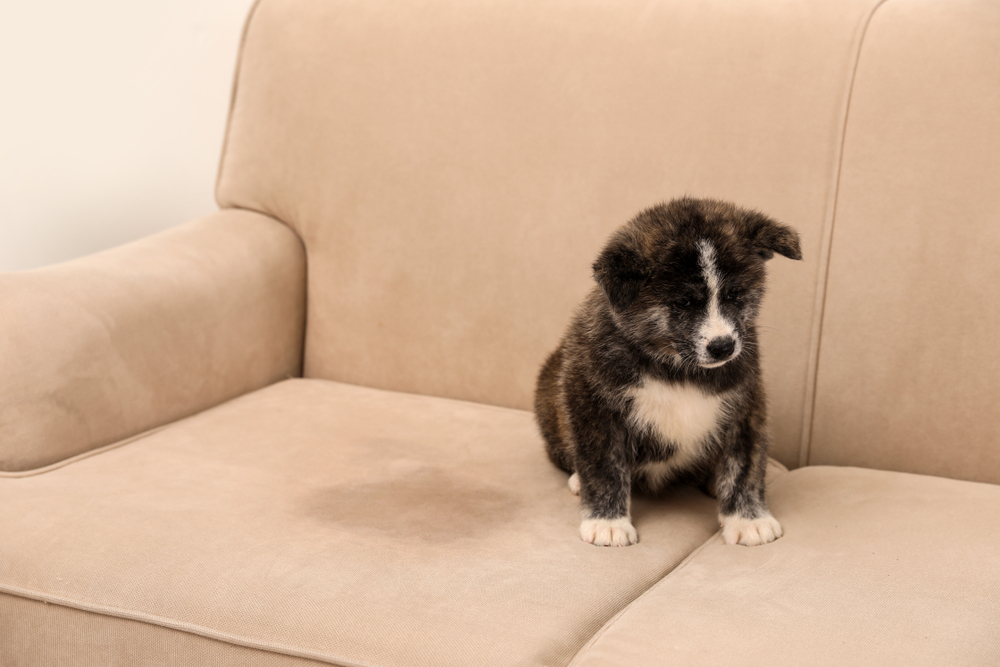If you’re trying to figure out how to stop your dog peeing on furniture, we can bet you’re in a pretty stressful phase with your pup. Unwanted marking behaviour is destructive, frustrating, and let’s face it, not endearing in the least.
What you need is a plan that will stop the peeing as soon as possible so that you and Fido can be on loving terms once again.
Luckily, with a few straightforward techniques, the help of a friendly Dog Walker, and maybe a consultation with the vet, your pup can get back to peeing only on their favourite trees and bushes—outside!

First things first: let’s assess why your dog is doing it
There are a few different reasons why your dog might see your furniture as the perfect potty spot.
Male dogs, for instance, may pee on the furniture as part of their instinct to mark their territory. In fact, they probably think it strange that you don’t pee on the furniture. How else will your houseguests know that you own this space? Marking behaviour can get worse when there are multiple dogs in the house or there’s an intact female in the neighbourhood.
But it’s not just male dogs who engage in this furniture-peeing habit. Puppies who haven’t been fully house-trained, senior dogs with incontinence issues, and dogs suffering from urinary tract infections can also pee inside from time to time.
There are also emotional reasons why a dog might pee on the furniture. Separation anxiety, submission or fear, and overexcitement can all prompt your pup to pee on the spot.
If you suspect your dog falls into one of these categories, you’ll be able to put together a plan to stop your dog peeing on furniture once and for all!
How to stop your dog peeing on furniture as part of their marking instinct
While some female dogs do mark territory, this behaviour is usually found in intact male doggos. Here are a few options for a furniture-marking Fido:
- Consider desexing. In addition to preventing pregnancy and lowering the risk for certain cancers, desexing can also decrease your dog’s desire to mark their territory.
- Invest in some powerful cleaners. Every so often, your dog will get the urge to do their regular pee patrol. This includes sniffing out the areas where they’ve already peed so they can reinforce the boundaries. Your task, then, is to eliminate all traces of their former pee parade. On fabrics, this can be quite a challenge, given your dog’s amazing sense of smell, so make sure to invest in enzyme cleaner specifically for dog urine and clean up the mess immediately after your dog pees.
- Place their bed in the area where they pee. Doggos don’t like to urinate where they snooze, so you might place their dog bed right next to the piece of furniture where they’ve been marking.
- Try the creative, if slightly unappealing, bandana method. If your dog tends to mark more than one piece of furniture, you may not have enough beds to place strategically around the house. Another option is the bandana method, which involves fitting your dog with a urine-marked bandana. That way, they’ll get the sense that their territory is well-marked already! Of course, this is a temporary fix while you work on getting them into the habit of marking outside.
- Consider crate training. For healthy adult dogs, crate training can be a good way to prevent marking in the home. Make sure that you don’t leave your pup in their crate for longer than they can hold their bladder, and plan on bringing them directly outside once it’s time for them to come out of their crate.
- Give your dog opportunities to scratch the instinctual itch. Even with all of your efforts, your dog may still feel the need to mark territory. There are simply some instincts that your dog will never grow out of. Instead of fighting nature, make sure that you give your dog plenty of opportunities to live out their pee patrolling desires. Daily walks throughout the neighbourhood, with yourself or a friendly Dog Walker, and praise for going potty outside will give them appropriate outlets.
How to stop your dog peeing on furniture as the result of separation anxiety, submission, or excitement
You come home from a long day at work only to find that your nervous pup has peed on the furniture while you were away. Or, perhaps, your overexcited dog pees the moment they hear you open the door.
For emotional pee behaviour, desensitisation can be very effective. This will involve working on your dog’s ability to stay calm in stressful or exciting situations so that they don’t feel the need to pee, chew, whine or engage in other coping mechanisms. Leaving them with an engaging chew toy or puzzle toy is another good way to manage their anxiety.
Desensitisation training requires quite a bit of time and patience as you build up your dog’s tolerance slowly. In the meantime, leaving your pup in the care of a local Pet Sitter can be a big help.
How to stop your dog peeing on furniture as the result of a medical issue
If you feel that your dog is peeing in the house because of a urinary tract infection or other medical condition, your vet can help. With a treatment plan, your pup may be able to get back to peeing outside in a matter of days or weeks.
Unfortunately peeing inside can be a more common occurrence as your dog ages. Whether they’re experiencing incontinence or dementia, these older pups will need some extra understanding and care when they have indoor accidents. And, if you’re looking for a sustainable solution, there are reusable dog nappies for puppers who can’t control their indoor accidents.
You’re on the way to a pee-free home
Addressing an indoor peeing habit can be a challenge. But once you know the source of your dog’s behaviour, it will be much easier to put a game plan in place.
Whether your dog is marking their territory, bursting with excitement at your return, or struggling with a medical issue, try to have some grace with your pup. They’re doing their best to be the most lovable doggo they can be. And with the help of a Dog Walker or your vet, you’re on the way to stop your dog peeing on furniture once and for all!

